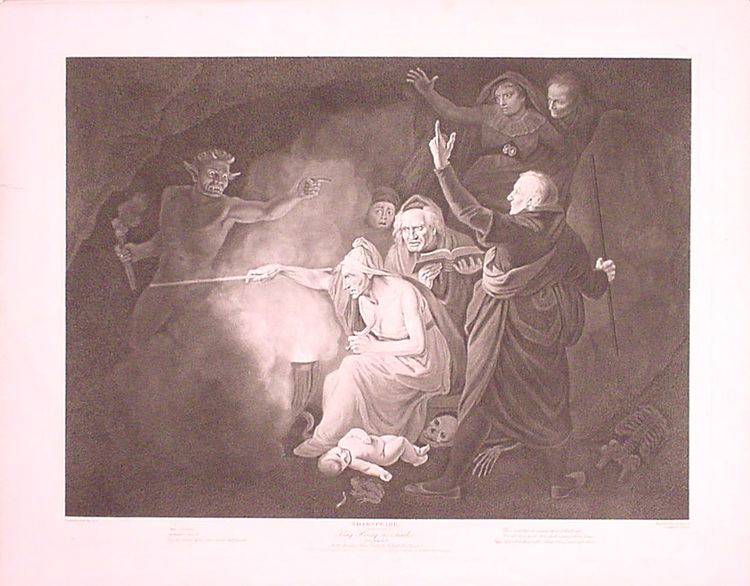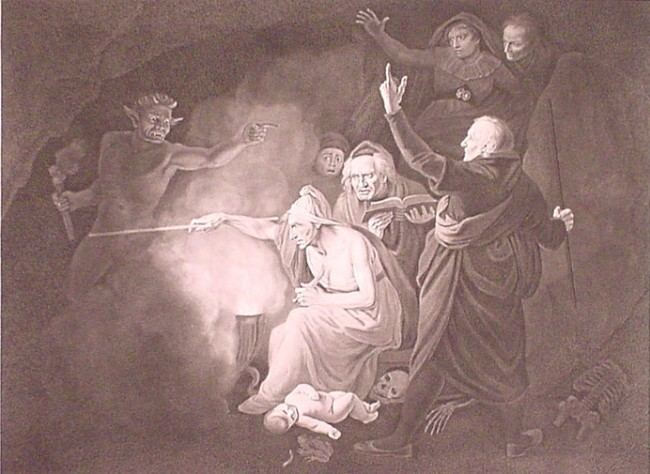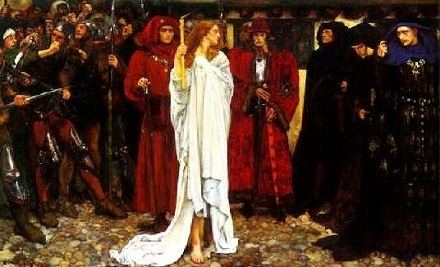Name Margery Jourdemayne | ||
 | ||
Died October 27, 1441, Smithfield, London, City of London, United Kingdom | ||
Margery Jourdemayne, "the Witch of Eye Next Westminster" (before 1415 – 27 October 1441) was an English woman who was accused of treasonable witchcraft and subsequently burned at the stake.
Contents

Life

Margery was married to William Jourdemayne. Although nothing is known of her own family, her husband's family of Jourdemayne were well established and prosperous Middlesex yeomen from at least the end of the fourteenth century. The meaning of the surname is likely to have come from the Old French for a day labourer–jour de main.
Activity
From the early 1430s, Margery seems to have kept the company of a number of respected and learned clerics and courtiers, somewhat unusually for the wife of a cowherd.
Eleanor Cobham admitted at her trial to having long used Margery's services. It seems that this was a relationship of at least ten years. Eleanor also stated that she had sought Margery's help in becoming pregnant by the Duke. It is likely that she and other ladies of the Court were well versed in Margery's profession.
Roger Bolingbroke was the best known of these scholars, described as a 'gret and konnyng man in astronomye' and 'renowned in all the world'.
There is some evidence of other notables using Margery's skills, such as Edmund Beaufort, 2nd Duke of Somerset, who is said to have consulted Margery Jourdemayne, the celebrated witch of Eye, with respect to his conduct and fate during the impending conflicts. She told him that he would be defeated and slain at a castle: but as long as he arrayed his forces and fought in the open field, he would be victorious and safe from harm.
Case of 1432
During the course of the 1441 trial, it was disclosed that Margery had been held for some months at Windsor Castle ten years previously for an unspecified offence concerning sorcery. In 1430, seven witches had been arrested in London and accused of plotting the young King Henry's death and were then imprisoned in the Fleet; it is possible that Margery was one of these seven.
On 9 May 1432, Margery, along with Friar John Ashwell and John Virley (clerk), was examined on charges of sorcery. Ashwell and Virley were discharged on their own recognisance, but Margery was released on condition of her future good behaviour and that she refrained from further witchcraft.
Case of 1441
The case that led to the execution of Margery Jourdemayne has been well documented and discussed since the fifteenth century. Eleanor Cobham, Duchess of Gloucester, wife to Humphrey of Lancaster, 1st Duke of Gloucester, was charged with heretical witchcraft, along with four co-accused. Three of the co-accused were scholars and clerics of the Duke's court. The fourth was Margery Jourdemayne, a woman of low birth, known as a witch. Humphrey was uncle to the young Henry VI of England and, if Henry were to have died, would have been successor to the throne.
At some point between July and September 1441, Margery was arrested by the King's men and taken to the Tower of London.
Eleanor Cobham, Roger Bolingbroke, John Hume (or Home), Thomas Southwell and Margery stood accused of using witchcraft to bring about the death of Henry VI. Bolingbroke was an Oxford scholar and Eleanor's personal clerk. Thomas Southwell was a physician and Canon of St Stephen's Chapel in the Palace of Westminster, Rector of St Stephen's Walbrook, London, and vicar of Ruislip. Hume was Canon of Hereford and St Asaph and chaplain and secretary to both Eleanor and the Duke. Margery, on the other hand, had for many years been known as someone who could provide spells and potions useful in advancing love and bringing about a pregnancy or ending one.
She was found guilty of heresy and witchcraft and sentenced to death by burning at Smithfield.
In literature
Margery appears in William Shakespeare's Henry VI, Part 2, as Margery Jourdayn, along with her co-accused. She is also a character in Philippa Gregory's 2011 novel about Jacquetta of Luxembourg, The Lady of the Rivers.
In popular culture
Deborah Hyde, editor-in-chief to the UK magazine The Skeptic is blogging and lecturing about belief in the supernatural and other elements of folklore that involve superstition under the name "Jourdemayne".
